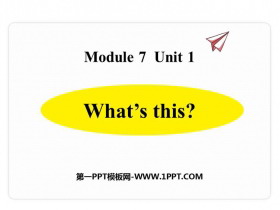







《Exploring English》Section ⅢPPT教学课件
第一部分内容:语言基础自测
Ⅰ.单词拼写
根据汉语或者首字母提示,写出下列单词
1.You can take the ______ (地铁)No.1 to get Tiananmen Square.
2.The story about their love has many different ______(版本).
3.The weather of today is______(相当;颇)hot compared to this time last year.
4.Please try to practice the ability to guess the work according to the______(上下文;语境).
5.One had better see life in its various______when young.
6.Please come to my ______for lunch after the meeting.
7.You can take the ______right to the top of the building.
8.People are living longer_________,and they are better educated.
Ⅱ.拓展词汇
根据词性和汉语提示,写出下列单词
1.______n.起源,起因→original adj.最初的,原始的→originate v.创始,起源于
2.______n.上下文,语境→contextual adj.与上下文有关的
3.______v.组成→formation n.组成,形成
4.tradition n.传统→ ______ adj.传统的→ ______adv.根据传统
Ⅲ.补全短语
根据提示补全下列短语
1.be known______ 为人所知
2.vice______ 反之亦然
3.be made up______ 由……组成
4.be different______ 与……不同
5.______...for example 以……为例
6.______you can see 正如你所见
7.would______宁愿;更喜欢
8.pick______拾起;捡起;开车接;偶然获得
Ⅳ.选词填空
选用上述短语的适当形式填空
1.______,we are low on cash these days so we have no more to lend.
2.He ______ some useful information while communicating with his customer.
3.______ traffic ______,many new overpasses being built proves the city's fast changes.
4.He______go there by bus in such a hot day than stay at home.
5.The changes in the traffic rules do not seem to ______ the public.
6.If you lose control of your drinking, you lose control of your partying,______.
7.The medical team to Zanzibar in Tanzania ______nine people.
8.What he told me about the accident______your description.
... ... ...
Exploring English PPT,第二部分内容:核心要点探究
be made up of由……组成
(教材P17)And sometimes a word is made up of the first letters of several words...
并且有时候一个单词由几个单词的首字母组成……
consist of 由……组成
be composed of 由……组成
be made of 由……材料制成
be made from 由……材料制成
make up 编造;化妆;组成;占比例
make up for 弥补
①New Zealand is made up of two islands,the larger of which is the South Island.
新西兰主要由两个岛屿组成,其中较大的为南岛。
②The collection consists of/is made up of/is composed of three parts:poems,essays and short stories.
这本作品集是由诗、散文和短篇小说三部分合编成的。
③We came into this field late, so we must work hard to make up ____ the lost time.
我们涉足这一领域较晚,因此我们必须努力工作,把失去的时间补回来。
④Future buildings, roads, and cities may be made______garbage.
将来的建筑物、公路和城市都可能用垃圾建造。
[名师点津]
be made up of,be composed of 和consist of都是表示“由……组成”,但是consist of 只能用主动,不可用于被动。be made of 和be made from都表示“由……材料制成”,区别在于后者看不出原材料。
would rather宁愿;宁可
(教材P18)And the Americans find the British spelling “re” does not match its pronunciation,so they would rather spell“re” as“er”.并且美国人发现英式拼写“re”和他们的发音不匹配,所以他们宁愿把“re”拼写成“er”。
(1)would rather do sth.than do sth.=would do sth.rather than do sth.=prefer to do sth.rather than do sth.宁愿……,也不……
(2)would rather (not) do sth.宁愿(不)做某事
(3)would rather+从句did (现在)had done(过去)
(4)rather than 而不是
(5)or rather 更确切地说
... ... ...
Exploring English PPT,第三部分内容:语法专项突破
构词法
语 境 自 主 领 悟
先观察原句
阅读下列句子,并体会黑体部分的用法
1.For example, in our free time we can sculpt a sculpture and paint a painting.
2.While we're doing all this traveling, we can get seasick at sea,airsick in the air and carsick in a car, but we don't get homesick when we get back home.
3.And speaking of home,why aren't homework and housework the same thing?
4.If harmless actions are the opposite of harmful actions, why are shameless and shameful behaviors the same?
5.When we look out of the window and see rain or snow,we can say “it's raining”or“it's snowing”.
6.When you see the capitalized “WHO”in a medical report, do you read it as the “who” in “Who's that?”What about“IT”and“US”.
后自主感悟
1.在例句1中的“sculpture”和“painting”都是 ,是_____“sculpt”和“paint”的______,分别加了名词后缀ure和ing。
2.在例句2中,“seasick,airsick,carsick以及homesick”都是______加上了形容词后缀sick组成的 。
3.在例句3中,homework,housework分别是home,house加上work组成的 。
4.在例句4中“harmless和harmful”以及“shameless和shameful”都是由词性为名词的harm和shame加上了形容词后缀less或ful组成的_______。
5.在例句5中“rain”和“snow”在词性上既可以作 也可以作________。
6.在例句6中“WHO”“IT”“US”都是______,和小写的who,it及us在读音和意义上大不相同。
... ... ...
Exploring English PPT,第四部分内容:语法精要点拨
语言的基本要素之一是词汇。在语言发展的最初阶段,人们使用的是少量而简单的词,这些词只表示日常简单的事物和概念,构成语言中最基本的词,称之为基本词或词根。随着社会的发展与进步,有限的原生词已不够用,人们便创造了一些新词来表示新生的事物和概念。英语中构词法可以分为合成法、派生法、转化法、截短法和缩略法。
一、合成
合成(Compounding):把两个或两个以上的单词合成一个新的单词的构词法。以合成法构成的单词叫作合成词,包括合成名词、合成动词、合成形容词、合成副词等。
1.合成名词
名词+名词weekend周末
名词+动名词handwriting书法
名词+介词+名词sisterinlaw嫂子
动词+名词typewriter打字机
动名词+名词readingroom阅览室
动词+and+动词hideandseek捉迷藏游戏
现在分词+名词flyingfish飞鱼
形容词+名词freshman大一新生
副词+动词outlook景色,风光
副词+名词evergreen常青树
2.合成形容词
名词+形容词bloodred血红的
名词+现在分词Frenchspeaking讲法语的
名词+to+名词onetoone一对一的
名词+过去分词manmade人造的
数词+名词oneway单行道的
数词+名词+形容词threeyearold三岁的
数词+名词+ed tenstoreyed十层的
数词+副词oneoff 一次性的
形容词+名词highquality高质量的
形容词+名词+ed nobleminded高尚的
形容词+形容词light green浅绿色的
形容词+现在分词ordinarylooking相貌一般的
副词+形容词evergreen常青的
副词+现在分词hardworking辛勤的
副词+过去分词wellknown著名的
副词+名词fast food专门提供快餐服务的
介词+名词indoor室内的
3.合成动词
名词+动词sleepwalk梦游
形容词+动词whitewash粉刷(墙壁等)
4.合成副词
形容词+名词hotfoot匆忙地
形容词+副词everywhere到处
副词+副词however尽管如此
介词+名词beforehand事先
介词+副词forever永远
5.合成代词
代词宾格+self/selves herself 她自己
物主代词+self/selves myself 我自己
themselves他们自己
ourselves我们自己
形容词+名词anything 一切
6.合成介词
副词+名词outside在……外面
介词+副词within在……之内
副词+介词into进入
二、派生
派生(Derivation):在一个词根之前或之后加上某个词缀来生成一个新词的构词法,即称作派生法。加在词根之前的词缀叫作前缀,加在词根之后的为后缀。
1.前缀
除少数英语前缀外,前缀一般改变单词的意义,不改变词性。
(1)表示否定意义的前缀常用的有dis, il, im, in, ir, mis, non, un等,在单词的前面加这类前缀常构成与该词意义相反的新词。例如:
agree同意→disagree不同意
fair公平的→unfair不公平的
possible可能的→impossible不可能的
understand理解→misunderstand误解
(2)表示其他意义的前缀常用的有a(多构成表语形容词), anti (反对;抵抗), auto(自动), co (共同), en(使), inter(互相), re(再;又), sub(下面的;次;小), tele(强调距离)等。例如:
coworker 同事,帮手
enlarge使变大
cooperate 合作
rewrite重写
subway 地铁
2.后缀
后缀通常会改变单词的词性,构成意义相近的其他词性;少数后缀还会改变词义,变为与原来词义相反的新词。下面仅作简单介绍。
(1)构成名词的后缀常用的有ence,(e)r/ or (从事某事的人),ese (某地人),ess (雌性),ian (精通……的人),ist (专业人员),ment (性质;状态),ness(性质;状态),tion(动作;过程)等。例如:
differ不同于→difference区别
write写→writer作家
China中国→Chinese中国人
act表演→actress女演员
music音乐→musician音乐家
(2)构成动词的后缀常用的有(e)n (多用于形容词之后),fy (使……化),ize (使……成为)。例如:
wide→widen加宽
beauty→beautify美化
pure→purify提纯
real→realize意识到
organ→organize组织
sharp→sharpen使变锋利
... ... ...
关键词:外研版高中英语必修一PPT课件免费下载,Exploring English PPT下载,.PPT格式;











